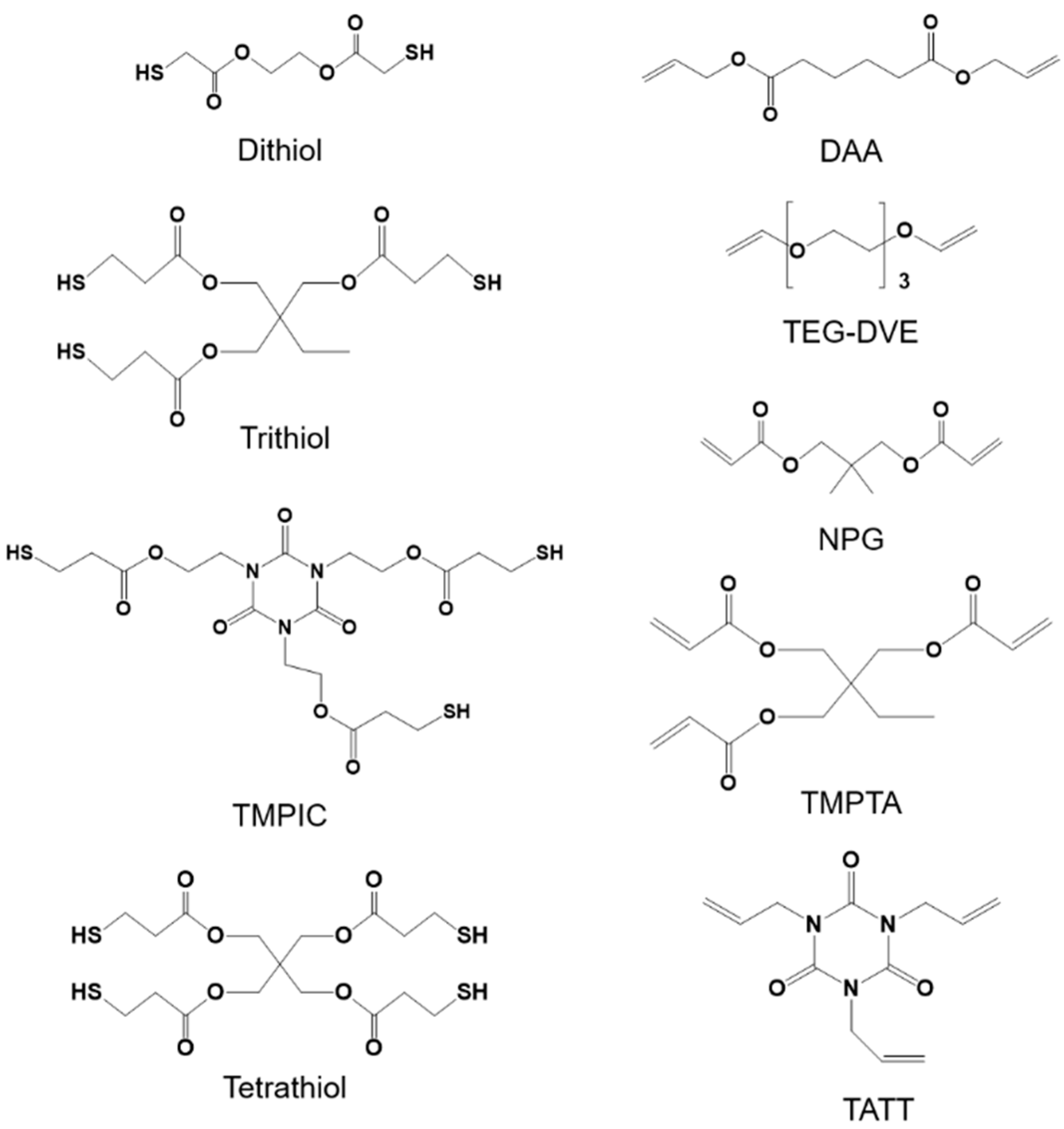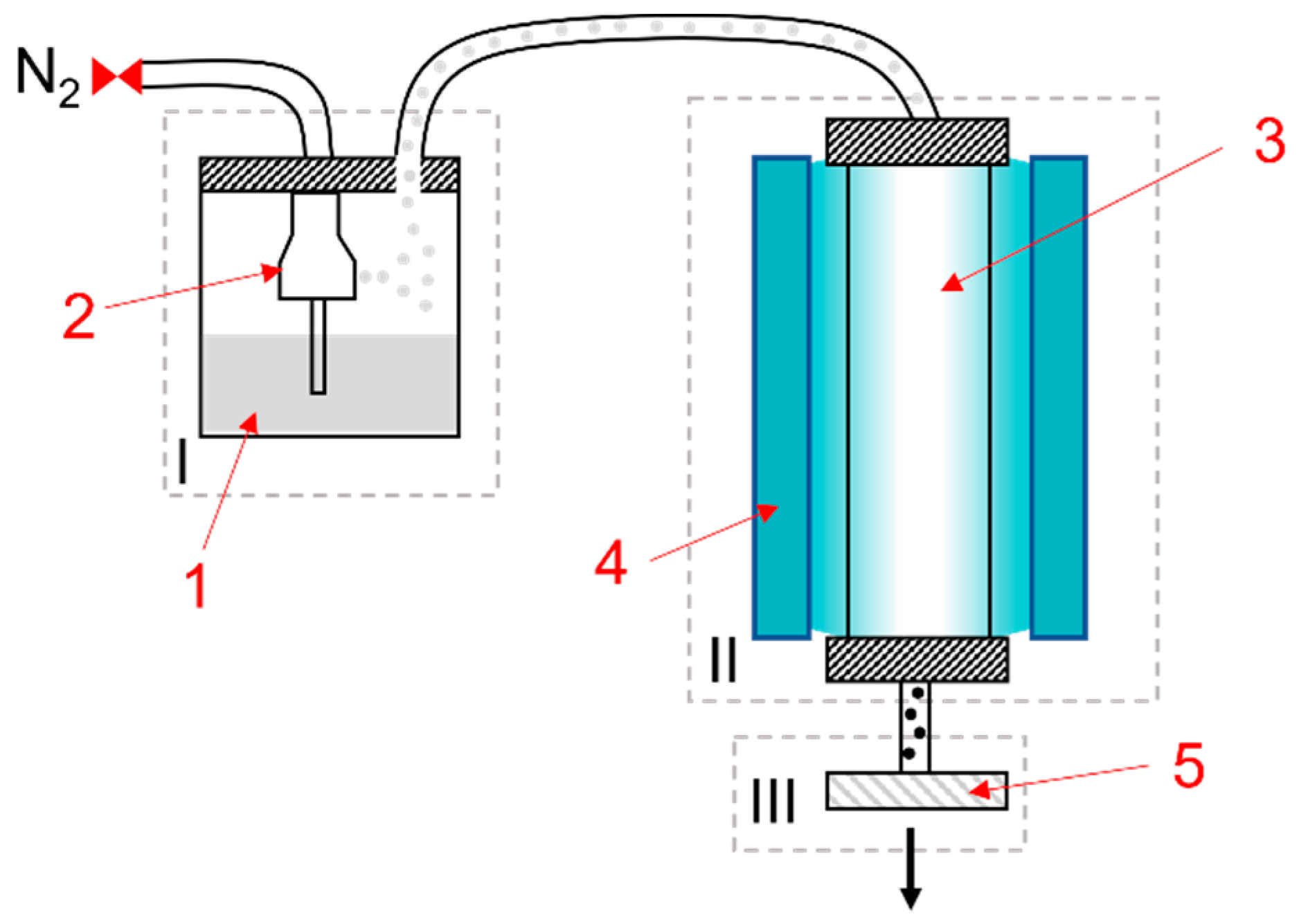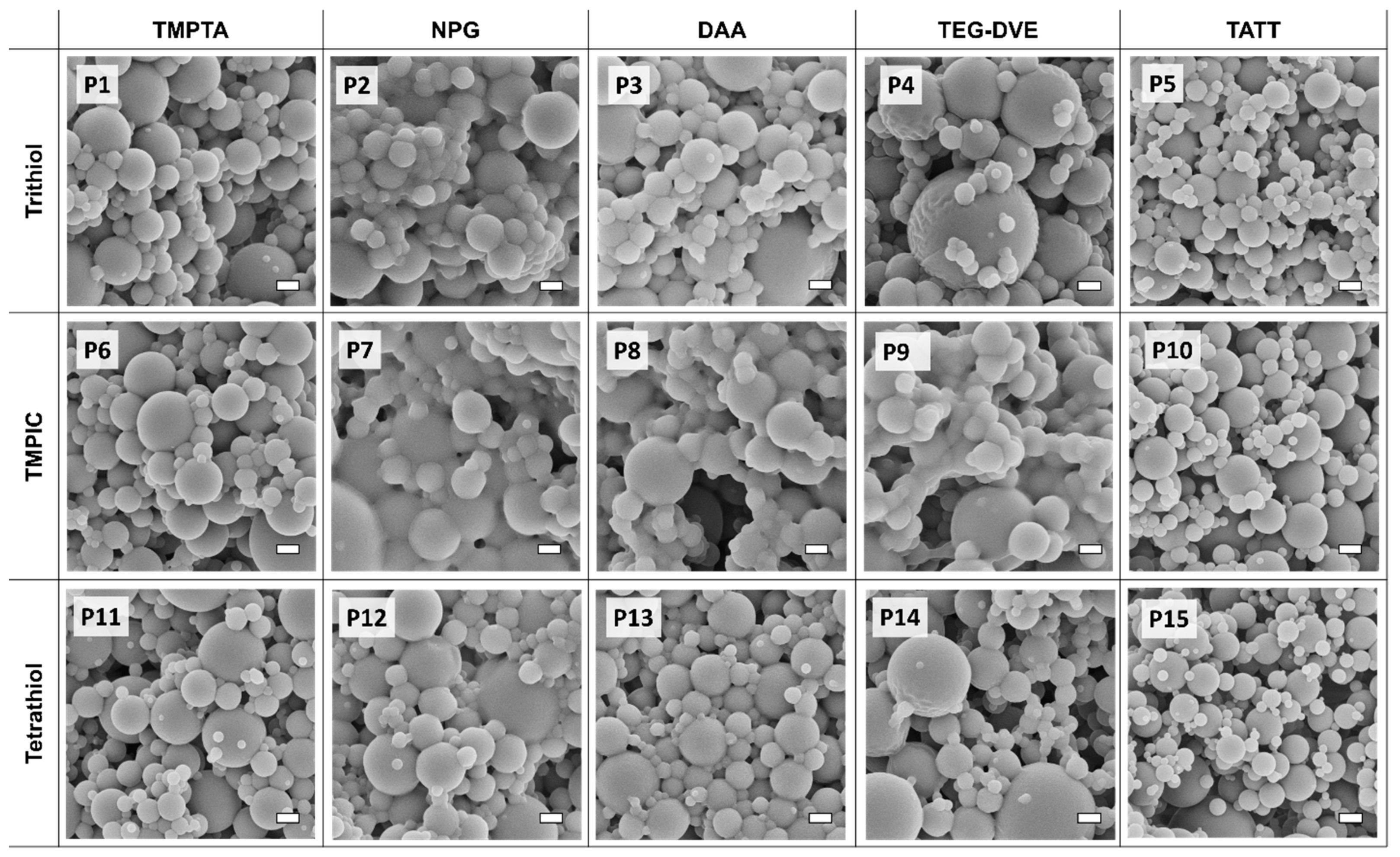Thiol-Functional Polymer Nanoparticles via Aerosol Photopolymerization
Abstract
:1. Introduction
2. Materials and Methods
2.1. Chemicals
2.2. Aerosol Photopolymerization Setup
2.3. Experiments
2.3.1. Preparation of Spray Solutions
2.3.2. Ellman’s Tests
2.4. Analysis Methods
2.4.1. Scanning Electron Microscopy (SEM)
2.4.2. Image Analysis of SEM Micrographs
3. Results and Discussion
3.1. Polymer Nanoparticles from Aerosol Thiol-Ene Photopolymerization
3.2. Ellman’s Test
3.3. Size Distribution Studies
4. Conclusions
Supplementary Materials
Author Contributions
Funding
Institutional Review Board Statement
Informed Consent Statement
Data Availability Statement
Acknowledgments
Conflicts of Interest
References
- Bennet, D.; Kim, S. Polymer Nanoparticles for Smart Drug Delivery; IntechOpen: London, UK, 2014; Volume 8. [Google Scholar]
- Feng, X.; Lv, F.; Liu, L.; Tang, H.; Xing, C.; Yang, Q.; Wang, S. Conjugated Polymer Nanoparticles for Drug Delivery and Imaging. ACS Appl. Mater. Interfaces 2010, 2, 2429–2435. [Google Scholar] [CrossRef]
- Ain, Q.U.; Khan, A.N.; Nabavinia, M.; Mujahid, M. Enhanced mechanical properties and biocompatibility of novel hydroxyapatite/TOPAS hybrid composite for bone tissue engineering applications. Mater. Sci. Eng. C 2017, 75, 807–815. [Google Scholar] [CrossRef]
- Peters, M.; Zaquen, N.; D’Olieslaeger, L.; Bové, H.; Vanderzande, D.; Hellings, N.; Junkers, T.; Ethirajan, A. PPV-Based Conjugated Polymer Nanoparticles as a Versatile Bioimaging Probe: A Closer Look at the Inherent Optical Properties and Nanoparticle–Cell Interactions. Biomacromolecules 2016, 17, 2562–2571. [Google Scholar] [CrossRef]
- Jiang, Y.; Pu, K. Multimodal Biophotonics of Semiconducting Polymer Nanoparticles. Acc. Chem. Res. 2018, 51, 1840–1849. [Google Scholar] [CrossRef] [PubMed]
- Yin, J.; Deng, B. Polymer-matrix nanocomposite membranes for water treatment. J. Membr. Sci. 2015, 479, 256–275. [Google Scholar] [CrossRef]
- Kim, J.; Van der Bruggen, B. The use of nanoparticles in polymeric and ceramic membrane structures: Review of manufacturing procedures and performance improvement for water treatment. Environ. Pollut. 2010, 158, 2335–2349. [Google Scholar] [CrossRef] [PubMed]
- Pradhan, N.; Singh, S.; Ojha, N.; Shrivastava, A.; Barla, A.; Rai, V.; Bose, S. Facets of nanotechnology as seen in food processing, packaging, and preservation industry. BioMed Res. Int. 2015, 2015, 365672. [Google Scholar] [CrossRef] [PubMed] [Green Version]
- Singh, T.; Shukla, S.; Kumar, P.; Wahla, V.; Bajpai, V.K.; Rather, I.A. Application of nanotechnology in food science: Perception and overview. Front. Microbiol. 2017, 8, 1501. [Google Scholar] [CrossRef] [Green Version]
- Rao, J.P.; Geckeler, K.E. Polymer nanoparticles: Preparation techniques and size-control parameters. Prog. Polym. Sci. 2011, 36, 887–913. [Google Scholar] [CrossRef]
- Venier-Julienne, M.C.; Benoît, J.P. Preparation, purification and morphology of polymeric nanoparticles as drug carriers. Pharm. Acta Helv. 1996, 71, 121–128. [Google Scholar] [CrossRef]
- Song, C.; Labhasetwar, V.; Murphy, H.; Qu, X.; Humphrey, W.; Shebuski, R.; Levy, R. Formulation and characterization of biodegradable nanoparticles for intravascular local drug delivery. J. Control. Release 1997, 43, 197–212. [Google Scholar] [CrossRef]
- Jeong, Y.-I.; Cho, C.-S.; Kim, S.-H.; Ko, K.-S.; Kim, S.-I.; Shim, Y.-H.; Nah, J.-W. Preparation of poly(DL-lactide-co-glycolide) nanoparticles without surfactant. J. Appl. Polym. Sci. 2001, 80, 2228–2236. [Google Scholar] [CrossRef]
- Yordanov, G.G.; Dushkin, C.D. Preparation of poly (butylcyanoacrylate) drug carriers by nanoprecipitation using a pre-synthesized polymer and different colloidal stabilizers. Colloid Polym. Sci. 2010, 288, 1019–1026. [Google Scholar] [CrossRef]
- Allémann, E.; Gurny, R.; Doelker, E. Preparation of aqueous polymeric nanodispersions by a reversible salting-out process: Influence of process parameters on particle size. Int. J. Pharm. 1992, 87, 247–253. [Google Scholar] [CrossRef]
- Cheng, X.; Chen, M.; Zhou, S.; Wu, L. Preparation of SiO2/PMMA composite particles via conventional emulsion polymerization. J. Polym. Sci. Part A Polym. Chem. 2006, 44, 3807–3816. [Google Scholar] [CrossRef]
- Bardajee, G.R.; Vancaeyzeele, C.; Haley, J.C.; Li, A.Y.; Winnik, M.A. Synthesis, characterization, and energy transfer studies of dye-labeled poly(butyl methacrylate) latex particles prepared by miniemulsion polymerization. Polymer 2007, 48, 5839–5849. [Google Scholar] [CrossRef]
- Jang, J.; Bae, J.; Ko, S. Synthesis and curing of poly(glycidyl methacrylate) nanoparticles. J. Polym. Sci. Part A Polym. Chem. 2005, 43, 2258–2265. [Google Scholar] [CrossRef]
- Pappas, S.P. Radiation Curing: Science and Technology; Springer Science & Business Media: Berlin/Heidelberg, Germany, 2013. [Google Scholar]
- Biskos, G.; Vons, V.; Yurteri, C.U.; Schmidt-Ott, A. Generation and Sizing of Particles for Aerosol-Based Nanotechnology. KONA Powder Part J. 2008, 26, 13–35. [Google Scholar] [CrossRef] [Green Version]
- Esen, C.; Schweiger, G. Preparation of Monodisperse Polymer Particles by Photopolymerization. J. Colloid Interface Sci. 1996, 179, 276–280. [Google Scholar] [CrossRef]
- Gao, Z.; Grulke, E.A.; Ray, A.K. Synthesis of monodisperse polymer microspheres by photopolymerization of microdroplets. Colloid Polym. Sci. 2007, 285, 847–854. [Google Scholar] [CrossRef]
- Akgün, E.; Hubbuch, J.; Wörner, M. Perspectives of aerosol-photopolymerization: Nanoscale polymer particles. Chem. Eng. Sci. 2013, 101, 248–252. [Google Scholar] [CrossRef]
- Akgün, E. Nanoscale Polymeric Particles via Aerosol-Photopolymerization; KIT Library (Published Internally): Karlsruhe, Germany, 2015. [Google Scholar]
- Akgün, E.; Hubbuch, J.; Wörner, M. Perspectives of aerosol-photopolymerization: Organic-inorganic hybrid nanoparticles. Colloid Polym. Sci. 2014, 292, 1241–1247. [Google Scholar] [CrossRef]
- Akgün, E.; Hubbuch, J.; Wörner, M. Perspectives of Aerosol-Photopolymerization: Nanostructured Polymeric Particles. Macromol. Mater. Eng. 2014, 299, 1316–1328. [Google Scholar] [CrossRef]
- Bazzano, M.; Latorre, D.; Pisano, R.; Sangermano, M.; Woerner, M. Nano-structured polymeric microparticles produced via cationic aerosol photopolymerization. J. Photochem. Photobiol. A Chem. 2017, 346, 364–371. [Google Scholar] [CrossRef]
- Bazzano, M.; Marchisio, D.; Sangermano, M.; Wörner, M.; Pisano, R. A molecular dynamics approach to nanostructuring of particles produced via aerosol cationic photopolymerization. Chem. Eng. Sci. 2019, 195, 1021–1027. [Google Scholar] [CrossRef]
- Hoelscher, F.; Cardoso, P.B.; Candiotto, G.; Guindani, C.; Feuser, P.; Araújo, P.H.H.; Sayer, C. In Vitro Degradation and Cytotoxicity Response of Biobased Nanoparticles Prepared by Thiol-ene Polymerization in Miniemulsion. J. Polym. Environ. 2021, 29, 3668–3678. [Google Scholar] [CrossRef]
- Yaşar, M.; Yöntem, F.D.; Kahraman, M.V.; Apohan, N.K.; Aktaş, Z.; Öncül, M.O.; Akçakaya, H. Polymeric nanoparticles for selective protein recognition by using thiol-ene miniemulsion photopolymerization. J. Biomater. Sci. Polym. Ed. 2020, 31, 2044–2059. [Google Scholar] [CrossRef]
- Lee, T.Y.; Roper, T.M.; Jonsson, E.S.; Guymon, C.A.; Hoyle, C.E. Thiol−Ene Photopolymerization Kinetics of Vinyl Acrylate/Multifunctional Thiol Mixtures. Macromolecules 2004, 37, 3606–3613. [Google Scholar] [CrossRef]
- Cramer, N.B.; Davies, T.; O’Brien, A.K.; Bowman, C.N. Mechanism and Modeling of a Thiol−Ene Photopolymerization. Macromolecules 2003, 36, 4631–4636. [Google Scholar] [CrossRef]
- Le, C.M.Q.; Vidal, L.; Schmutz, M.; Chemtob, A. Droplet nucleation in miniemulsion thiol–ene step photopolymerization. Polym. Chem. 2021, 12, 2084–2094. [Google Scholar] [CrossRef]
- Quoc Le, C.M.; Schmutz, M.; Chemtob, A. Ab Initio Batch Emulsion Thiol–Ene Photopolymerization. Macromolecules 2020, 53, 2369–2379. [Google Scholar] [CrossRef]
- Hoyle, C.E.; Bowman, C.N. Thiol–Ene Click Chemistry. Angew. Chem. Int. Ed. 2010, 49, 1540–1573. [Google Scholar] [CrossRef]
- Jasinski, F.; Rannée, A.; Schweitzer, J.; Fischer, D.; Lobry, E.; Croutxé-Barghorn, C.; Schmutz, M.; Le Nouen, D.; Criqui, A.; Chemtob, A. Thiol–Ene Linear Step-Growth Photopolymerization in Miniemulsion: Fast Rates, Redox-Responsive Particles, and Semicrystalline Films. Macromolecules 2016, 49, 1143–1153. [Google Scholar] [CrossRef] [Green Version]
- Cramer, N.B.; Reddy, S.K.; O’Brien, A.K.; Bowman, C.N. Thiol−Ene Photopolymerization Mechanism and Rate Limiting Step Changes for Various Vinyl Functional Group Chemistries. Macromolecules 2003, 36, 7964–7969. [Google Scholar] [CrossRef]
- Chiou, B.-S.; English, R.J.; Khan, S.A. Rheology and Photo-Cross-Linking of Thiol−Ene Polymers. Macromolecules 1996, 29, 5368–5374. [Google Scholar] [CrossRef]
- Northrop, B.H.; Coffey, R.N. Thiol–Ene Click Chemistry: Computational and Kinetic Analysis of the Influence of Alkene Functionality. J. Am. Chem. Soc. 2012, 134, 13804–13817. [Google Scholar] [CrossRef]
- Jasinski, F.; Lobry, E.; Tarablsi, B.; Chemtob, A.; Croutxé-Barghorn, C.; Le Nouen, D.; Criqui, A. Light-Mediated Thiol–Ene Polymerization in Miniemulsion: A Fast Route to Semicrystalline Polysulfide Nanoparticles. ACS Macro Lett. 2014, 3, 958–962. [Google Scholar] [CrossRef]
- Landfester, K. The Generation of Nanoparticles in Miniemulsions. Adv. Mater. 2001, 13, 765–768. [Google Scholar] [CrossRef]
- Landfester, K. Miniemulsion Polymerization and the Structure of Polymer and Hybrid Nanoparticles. Angew. Chem. Int. Ed. 2009, 48, 4488–4507. [Google Scholar] [CrossRef]
- Li, M.; Daniels, E.S.; Dimonie, V.; Sudol, E.D.; El-Aasser, M.S. Preparation of Polyurethane/Acrylic Hybrid Nanoparticles via a Miniemulsion Polymerization Process. Macromolecules 2005, 38, 4183–4192. [Google Scholar] [CrossRef]
- Akgün, E.; Muntean, A.; Hubbuch, J.; Wörner, M.; Sangermano, M. Cationic Aerosol Photopolymerization. Macromol. Mater. Eng. 2015, 300, 136–139. [Google Scholar] [CrossRef]
- Matsumoto, A.; Inoue, H.; Matsumoto, T.; Masayoshioiwa; Kimura, T.; Saito, H. Comparison of Gelation in the Free-Radical Polymerization of Triallyl Isocyanurate and its Isomer Triallyl Cyanurate. J. Macromol. Sci. Part A Chem. 1989, 26, 1279–1289. [Google Scholar] [CrossRef]
- Jansen, J.F.G.A.; Dias, A.A.; Dorschu, M.; Coussens, B. Fast Monomers: Factors Affecting the Inherent Reactivity of Acrylate Monomers in Photoinitiated Acrylate Polymerization. Macromolecules 2003, 36, 3861–3873. [Google Scholar] [CrossRef]
- Salinas, C.N.; Anseth, K.S. Mixed Mode Thiol−Acrylate Photopolymerizations for the Synthesis of PEG−Peptide Hydrogels. Macromolecules 2008, 41, 6019–6026. [Google Scholar] [CrossRef]
- Giannakitsas, I. Mixed Mode Polymerization; Illinois Institute of Technology: Chicago, IL, USA, 1999. [Google Scholar]




| Spray Solution | Thiol | Thiol Qtty (mM) | Alkene | Alkene Qtty (mM) | Functional Group Ratio | Solvent |
|---|---|---|---|---|---|---|
| P1 | Trithiol | 14.4 | TMPTA | 14.4 | 3−SH:3−C=C | EtOH |
| P2 | Trithiol | 13.9 | NPG | 20.9 | 2(3−SH):3(2−C=C) | EtOH |
| P3 | Trithiol | 13.5 | DAA | 20.3 | 2(3−SH):3(2−C=C) | EtOH |
| P4 | Trithiol | 14.2 | TEG-DVE | 21.3 | 2(3−SH):3(2−C=C) | EtOH |
| P5 | Trithiol | 15.4 | TATT | 15.4 | 3−SH:3−C=C | AcO |
| P6 | TMPIC | 12.1 | TMPTA | 12.1 | 3−SH:3−C=C | AcO |
| P7 | TMPIC | 11.8 | NPG | 17.8 | 2(3−SH):3(2−C=C) | AcO |
| P8 | TMPIC | 11.6 | DAA | 17.3 | 2(3−SH):3(2−C=C) | AcO |
| P9 | TMPIC | 12.1 | TEG-DVE | 18.1 | 2(3−SH):3(2−C=C) | AcO |
| P10 | TMPIC | 12.9 | TATT | 12.9 | 3−SH:3−C=C | MeCN |
| P11 | Tetrathiol | 11.3 | TMPTA | 15.1 | 3(4−SH):4(3−C=C) | MeCN |
| P12 | Tetrathiol | 10.9 | NPG | 21.9 | 4−SH:2(2−C=C) | MeCN |
| P13 | Tetrathiol | 10.6 | DAA | 21.3 | 4−SH:2(2−C=C) | MeCN |
| P14 | Tetrathiol | 11.2 | TEG-DVE | 22.3 | 4−SH:2(2−C=C) | MeCN |
| P15 | Tetrathiol | 12.2 | TATT | 16.2 | 3(4−SH):4(3−C=C) | MeCN |
Publisher’s Note: MDPI stays neutral with regard to jurisdictional claims in published maps and institutional affiliations. |
© 2021 by the authors. Licensee MDPI, Basel, Switzerland. This article is an open access article distributed under the terms and conditions of the Creative Commons Attribution (CC BY) license (https://creativecommons.org/licenses/by/4.0/).
Share and Cite
Suvarli, N.; Perner-Nochta, I.; Hubbuch, J.; Wörner, M. Thiol-Functional Polymer Nanoparticles via Aerosol Photopolymerization. Polymers 2021, 13, 4363. https://doi.org/10.3390/polym13244363
Suvarli N, Perner-Nochta I, Hubbuch J, Wörner M. Thiol-Functional Polymer Nanoparticles via Aerosol Photopolymerization. Polymers. 2021; 13(24):4363. https://doi.org/10.3390/polym13244363
Chicago/Turabian StyleSuvarli, Narmin, Iris Perner-Nochta, Jürgen Hubbuch, and Michael Wörner. 2021. "Thiol-Functional Polymer Nanoparticles via Aerosol Photopolymerization" Polymers 13, no. 24: 4363. https://doi.org/10.3390/polym13244363
APA StyleSuvarli, N., Perner-Nochta, I., Hubbuch, J., & Wörner, M. (2021). Thiol-Functional Polymer Nanoparticles via Aerosol Photopolymerization. Polymers, 13(24), 4363. https://doi.org/10.3390/polym13244363







